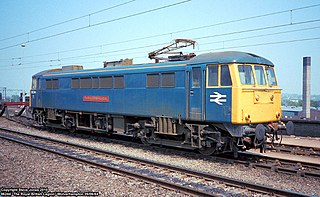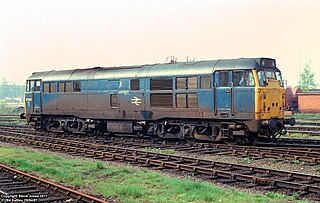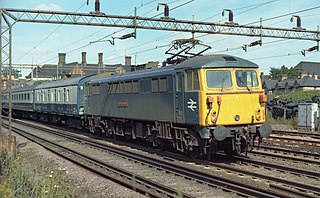
The British Rail Class 55, also known as a Deltic, or English Electric Type 5, is a class of diesel locomotive built in 1961 and 1962 by English Electric for British Railways. Twenty-two locomotives were built, designed for the high-speed express passenger services on the East Coast Main Line (ECML) between Edinburgh and London King's Cross. They gained the name "Deltic" from the prototype locomotive, DP1 Deltic, which in turn was named after its Napier Deltic power units.

The British Rail Class 02 are a class of twenty 0-4-0 diesel-hydraulic shunting locomotives built by the Yorkshire Engine Company in 1960 and 1961 (D2860-D2869) for service in areas of restricted loading gauge and curvature such as docks. They had the door to the cab at the rear, with a railed veranda behind the cab; this feature was very unusual on British Rail locomotives, although it was used on many Yorkshire Engine Co. designs and is quite normal in North American practice.

The British Rail Class 06 is a class of 0-4-0 diesel-mechanical shunters built by Andrew Barclay Sons and Company from 1958 to 1960 for use on the Scottish Region of British Railways. They were originally numbered D2410–D2444 and survivors after 1973 were given the TOPS numbers 06001–06010.

The British Rail Class 07 diesel locomotive is an off-centre cab 0-6-0 diesel-electric shunter type built by Ruston & Hornsby in 1962 for the Southern Region of British Railways. The 14 members of the class were primarily used at Southampton Docks and later also at Eastleigh Works.

The British Rail Class 89 is a prototype electric locomotive. Only one was built, in 1986, by British Rail Engineering Limited's Crewe Works. It was used on test-trains on both the West Coast and East Coast Main Lines. The locomotive was fitted with advanced power control systems and developed more than 6,000 bhp. After being withdrawn in 1992, it was returned to service in 1996, before being again withdrawn in 2000. As of January 2021, it is in the final stages of an overhaul that will return it to the main line.

The British Rail Class 86 is a class of electric locomotives built during the 1960s. Developed as a 'standard' electric locomotive from earlier prototype models, one hundred of these locomotives were built from 1965 to 1966 to haul trains on the then newly electrified West Coast Main Line (WCML) from London Euston to Birmingham, Crewe, Liverpool, Manchester and later Glasgow and Preston. Introduction of the class enabled the replacement of many steam locomotives, which were finally withdrawn by British Rail in 1968.

The British Rail Class 31 diesel locomotives, also known as the Brush Type 2 and previously as Class 30, were built by Brush Traction from 1957 to 1962. They were numbered in two series, D5500-D5699 and D5800-D5862. Construction of the first locomotive was completed in the final week of September 1957, and the handing-over took place on 31 October. The first Class 31 entered service in November 1957, after the launch of the Class 20 locomotive and was one of the Pilot Scheme locomotives ordered by British Railways to replace steam traction.
FM Rail was a railway charter company based in Derby, England. The company was formed when spot hire company Fragonset Railways and charter operator Merlin Rail merged. It went into administration in 2006.

The British Rail Class 73 is a British electro-diesel locomotive. The type is unusual in that it can operate from the Southern Region's 650/750 V DC third-rail or an on-board diesel engine to allow it to operate on non-electrified routes. This makes it very versatile, although the diesel engine produces less power than is available from the third-rail supply so the locomotives are rarely operated outside of the former Southern Region of British Rail. It is one of the first bi-mode locomotives ever built. Following the withdrawal and scrapping of the more powerful Class 74 bi-mode locomotives in 1977, the Class 73 was unique on the British railway network until the introduction of the Class 88 bi-mode locomotives in 2017. Ten locomotives have been scrapped.

Woodham Brothers Ltd is a trading business, based mainly around activities and premises located within Barry Docks, in Barry, South Wales. It is noted globally for its 1960s activity as a scrapyard, where 297 withdrawn British Railways steam locomotives were sent, from which 213 were rescued for the developing railway preservation movement.

The British Rail Class 87 is a type of electric locomotive designed and built by British Rail Engineering Limited (BREL) between 1973 and 1975. A total of thirty-six locomotives were constructed, to work passenger and freight services over the West Coast Main Line (WCML).

The British Rail Class 37 is a diesel-electric locomotive. Also known as the English Electric Type 3, the class was ordered as part of the British Rail modernisation plan. They were numbered in two series, D6600–D6608 and D6700–D6999.

The British Rail Class 60 is a class of Co-Co heavy freight diesel-electric locomotives built by Brush Traction. They are nicknamed Tugs by rail enthusiasts.

The British Rail Class 20, otherwise known as an English Electric Type 1, is a class of diesel-electric locomotive. In total, 228 locomotives in the class were built by English Electric between 1957 and 1968, the large number being in part because of the failure of other early designs in the same power range to provide reliable locomotives.

The British Rail Class 56 is a type of diesel locomotive designed for heavy freight work. It is a Type 5 locomotive, with a Ruston-Paxman power unit developing 3,250 bhp, and has a Co-Co wheel arrangement. Enthusiasts nicknamed them "Gridirons", due to the grid-like horn cover on the locomotive's cab ends fitted to nos. 56056 onwards. Under its Romanian railway factory nomenclature, the locomotive was named Electroputere LDE 3500, with LDE coming from Locomotivă Diesel-Electrică and the 3500 being the planned horsepower output.

The British Rail Class 59 is a fleet of Co-Co diesel-electric locomotives built between 1985 and 1995 by the Electro-Motive Division of General Motors for use in Great Britain. A total of 15 locomotives were built for three different operators.

The British Rail Class 504 was a unique type of electric multiple unit that ran on 1,200 V DC third rail with side-contact current collection. All other mainline UK third rails have the electric "shoe" on top of the rail. The type was used only on the Bury Line between Manchester and Bury. They were built in 1959 at Wolverton Works, and the body was a standard type used for several electrification schemes of the time, but the high DC voltage through a side-contact third rail was unique in Britain. The trains replaced the previous five-car units built by the Lancashire and Yorkshire Railway (LYR) for the route, which had inaugurated this electrification scheme in 1916.

GB Railfreight (GBRf) is a rail freight company in the United Kingdom. As of 2022, it is owned by the global investment company Infracapital, itself a subsidiary of M&G plc, a UK investment group.

Hanson Traction Ltd was a locomotive leasing company based at Washwood Heath, Birmingham, West Midlands.



















